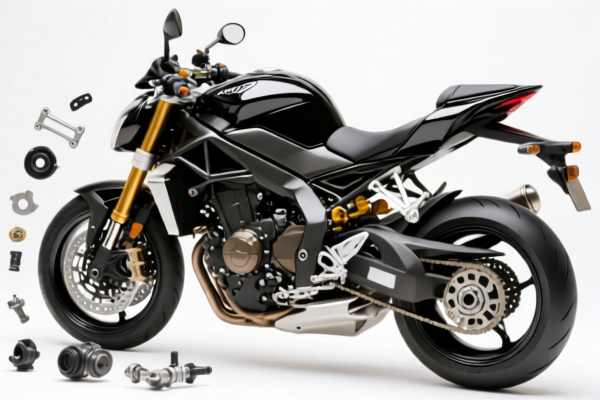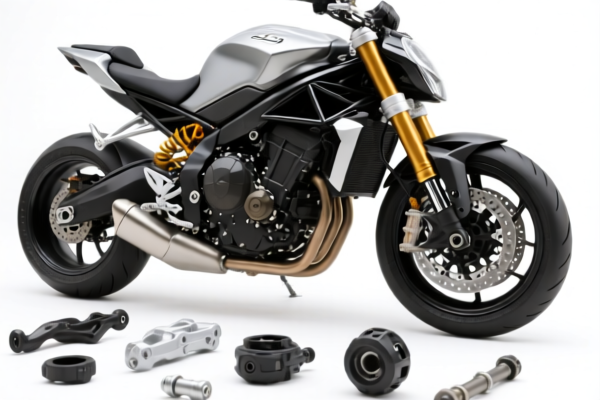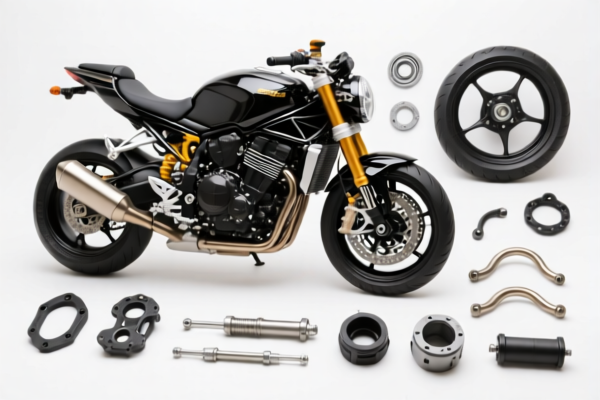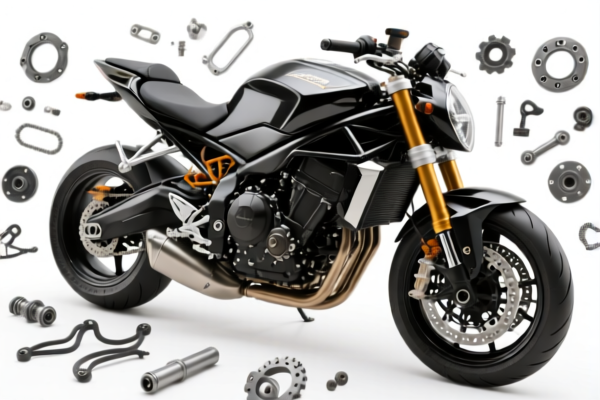| HS Code | Official Doc | Tariff Rate | Origin | Destination | Effective Date |
|---|---|---|---|---|---|
| 8714100010 | Doc | 37.5% | CN | US | 2025-05-12 |
| 8714100020 | Doc | 37.5% | CN | US | 2025-05-12 |
| 8711900100 | Doc | 55.0% | CN | US | 2025-05-12 |
| 7326908688 | Doc | 82.9% | CN | US | 2025-05-12 |
| 7326908688 | Doc | 82.9% | CN | US | 2025-05-12 |
| 8487900080 | Doc | 83.9% | CN | US | 2025-05-12 |
| 8487900040 | Doc | 58.9% | CN | US | 2025-05-12 |
| 8483101010 | Doc | 57.5% | CN | US | 2025-05-12 |
| 8483908040 | Doc | 57.8% | CN | US | 2025-05-12 |




Motorcycle Spare Parts
Motorcycle spare parts encompass a wide range of components used for the repair, maintenance, and modification of motorcycles. These parts are crucial for ensuring the vehicle's safe operation, optimal performance, and longevity.
Material
The materials used in motorcycle spare parts vary greatly depending on the specific component and its function. Common materials include:
- Steel: Used extensively in frames, forks, wheels, sprockets, and engine components due to its strength and durability. Alloy steels are common for increased strength-to-weight ratio.
- Aluminum Alloys: Frequently employed in engine casings, wheels, handlebars, and other components where weight reduction is critical.
- Plastic/Polymers: Used for body panels, fairings, seats, and certain interior components. ABS plastic is common for impact resistance.
- Rubber: Essential for tires, seals, hoses, and grips.
- Carbon Fiber: Increasingly used in high-performance applications for weight reduction and increased strength (fairings, exhausts).
- Ceramics/Composites: Found in brake pads, clutch linings, and specialized engine components for heat resistance and wear reduction.
Purpose
The primary purpose of motorcycle spare parts is to:
- Repair: Replace damaged or worn components resulting from accidents, wear and tear, or mechanical failure.
- Maintenance: Replace parts at specified intervals to prevent failures and maintain optimal performance (e.g., oil filters, spark plugs, brake pads).
- Modification/Upgrades: Enhance performance, aesthetics, or functionality of the motorcycle.
Function (Categorization of Parts)
Motorcycle spare parts can be broadly categorized by function:
- Engine Parts: Cylinders, pistons, crankshafts, camshafts, valves, spark plugs, carburetors/fuel injectors, oil pumps, water pumps, filters, gaskets.
- Transmission Parts: Gears, chains/belts, sprockets, clutches, shift levers.
- Braking System Parts: Brake pads, brake rotors, brake calipers, master cylinders, brake lines, brake fluid.
- Suspension Parts: Forks, shock absorbers, springs, bushings, steering dampers.
- Electrical System Parts: Batteries, starters, alternators, regulators, lights, wiring harnesses, sensors, ignition coils.
- Frame & Body Parts: Frames, subframes, fairings, seats, fuel tanks, fenders, handlebars, footpegs.
- Wheels & Tires: Rims, spokes, tires, tubes, valve stems.
- Cooling System Parts: Radiators, coolant hoses, thermostats, water pumps.
- Exhaust System Parts: Headers, mufflers, catalytic converters.
- Air Intake System Parts: Air filters, air boxes, throttle bodies.
Usage Scenarios
- Routine Maintenance: Replacing consumable parts like oil filters, spark plugs, and brake pads at regular intervals.
- Accident Repair: Replacing damaged parts after a collision.
- Performance Upgrades: Installing high-performance exhausts, upgraded suspension components, or larger carburetors/fuel injectors.
- Restoration: Replacing original parts to restore a vintage motorcycle to its original condition.
- Customization: Modifying the motorcycle with aftermarket parts to personalize its appearance or functionality.
Common Types (Aftermarket vs. OEM)
- OEM (Original Equipment Manufacturer) Parts: Parts manufactured by the same company that produced the original parts for the motorcycle. Generally considered the highest quality and best fit, but often more expensive.
- Aftermarket Parts: Parts manufactured by companies other than the original manufacturer. Can range in quality and price.
- Performance Aftermarket: Designed to improve performance (e.g., racing exhausts, high-flow air filters).
- Replacement Aftermarket: Designed to be direct replacements for OEM parts, often at a lower price point.
- Universal Aftermarket: Parts designed to fit a variety of motorcycle models. May require modification for proper fitment.
- Used/Salvaged Parts: Parts removed from used motorcycles. Can be a cost-effective option, but condition can vary.
Motorcycle spare parts encompass a variety of components used in the maintenance, repair, or enhancement of motorcycles. These parts can range from engine components to bodywork and electrical systems.
The following HS codes are relevant to motorcycle spare parts, based on the provided information:
- 8714100010: Parts and accessories of vehicles of headings 8711 to 8713: Of motorcycles (including mopeds) Saddles and seats. This code specifically covers saddles and seats designed for motorcycles and mopeds.
- 87: Vehicles and parts thereof.
- 14: Parts and accessories of vehicles.
- 100010: Specifically for motorcycles (including mopeds) saddles and seats.
- 8714100020: Parts and accessories of vehicles of headings 8711 to 8713: Of motorcycles (including mopeds) Wheels. This code covers wheels intended for use on motorcycles and mopeds.
- 87: Vehicles and parts thereof.
- 14: Parts and accessories of vehicles.
- 100020: Specifically for motorcycles (including mopeds) wheels.
- 8483101010: Transmission shafts (including camshafts and crankshafts) and cranks; bearing housings, housed bearings and plain shaft bearings; gears and gearing; ball or roller screws; gear boxes and other speed changers, including torque converters; flywheels and pulleys, including pulley blocks; clutches and shaft couplings (including universal joints); parts thereof: Transmission shafts (including camshafts and crankshafts) and cranks: Camshafts and crankshafts: Designed for use solely or principally with spark-ignition internal combustion piston engines or rotary engines For vehicles of chapter 87: For motorcycles. This code covers camshafts and crankshafts specifically designed for motorcycles.
- 84: Nuclear reactors, boilers, machinery and mechanical appliances; parts thereof.
- 83: Transmission shafts, bearings, gears, gearing and driving or transmission elements.
- 101010: Specifically for motorcycles.
- 8483908040: Transmission shafts (including camshafts and crankshafts) and cranks; bearing housings, housed bearings and plain shaft bearings; gears and gearing; ball or roller screws; gear boxes and other speed changers, including torque converters; flywheels and pulleys, including pulley blocks; clutches and shaft couplings (including universal joints); parts thereof: Toothed wheels, chain sprockets and other transmission elements presented separately; parts: Other: Other Parts of universal joints. This code covers parts of universal joints for motorcycle transmissions.
- 84: Nuclear reactors, boilers, machinery and mechanical appliances; parts thereof.
- 83: Transmission shafts, bearings, gears, gearing and driving or transmission elements.
- 908040: Specifically for parts of universal joints.
- 8487900040: Machinery parts, not containing electrical connectors, insulators, coils, contacts or other electrical features, and not specified or included elsewhere in this chapter: Other Oil seals, other than those of chapter 40. This code covers oil seals for motorcycle machinery, excluding those classified under chapter 40.
- 84: Nuclear reactors, boilers, machinery and mechanical appliances; parts thereof.
- 87: Parts of machinery.
- 900040: Specifically for oil seals.
Regarding HS code 8483101010, please note that it specifically applies to camshafts and crankshafts designed for spark-ignition internal combustion piston engines or rotary engines used in motorcycles.
Regarding HS code 8487900040, please note that oil seals classified under chapter 40 are excluded from this code.
Customer Reviews
I was able to quickly find the HS code and tariff details I needed. Great for someone who's new to international trade.
The page had the right info, but I found it a bit dry. More visuals or a step-by-step guide would have made it more engaging.
Perfect resource for understanding HS Code 3925 and its application for plastic doors. I'll be recommending this to my colleagues.
The information on export tariffs was straightforward and easy to follow. A bit more examples would have been nice, but overall solid.
I was looking for details on the 5% tariff rate for plastic doors, and this page had it all. Extremely helpful for my business.